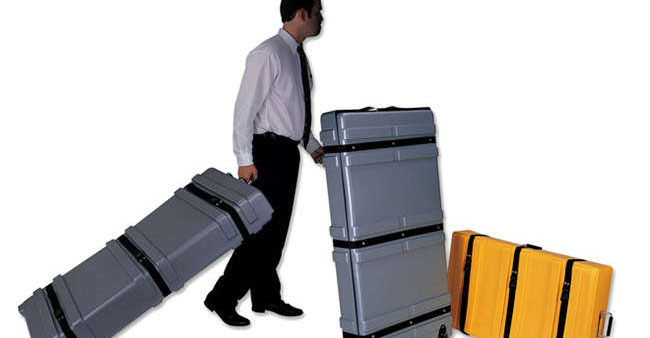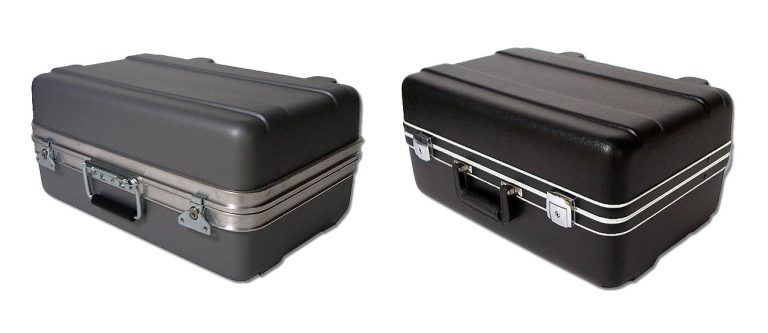Contact Us (866) 235-2472 info@bel-air-cases.com
Plastic Carrying Cases & HDPE: 8 Fascinating Facts
At Bel-Air Cases, we’ve been creating top-quality plastic carrying cases for more than 50 years. Our cases are tough and durable and many of our customers are surprised to learn that plastic is one of the best materials available to protect your expensive equipment. At our factory, we create cases using high-density polyethylene or HDPE, which is one of the most versatile plastics on earth. Here’s a quick look at HDPE and why it’s so well suited for custom plastic carrying cases.
1. HDPE Is Durable
While all of our plastic carrying cases are protective and durable, our shipping cases and expo cases, both of which are crafted from HDPE, are capable of handling the rigors of shipping and transport. HDPE is highly impact resistant, which makes it a top choice for any type of shipping case or crate.
2. HDPE Is Lightweight
While durability is certainly a huge advantage of HDPE, the light weight of this plastic also is a benefit. The light weight makes it easy for clients to move our cases from place to place, and the lighter weight also can reduce your shipping costs. Of course, we also can add wheels to our plastic carrying cases to make them as easy as possible to move.
3. HDPE Is Moisture-Resistant
Did someone spill coffee on your case? Did you have to transport your case from your car to an office building in a torrential downpour? Did you store your case in an area where mold or mildew have built up? If any of these scenarios have happened to you, the contents of your case are likely perfectly fine. HDPE is resistant to chemicals, moisture, mildew and mold, so whether you have suffered from a horrible cappuccino accident or got stuck in a thunderstorm, your HDPE plastic carrying cases will weather the storm.
3. HDPE Is A Thermoform Plastic
There are two basic types of plastic – thermoform plastics and thermoset plastics. Both involve the use of heat and this heat is applied to sheets of plastics in order to make the plastic malleable. However, thermoform plastics typically can be recycled and used again and again. With thermoset plastic, recycling is nearly impossible as these plastics are permanently “set†once they have cooled. HDPE is a thermoform plastic, meaning that it can be “re-melted†and used again for a new purpose.
4. HDPE Is Easily Recyclable
Our Bel-Air plastic carrying cases are meant to last a lifetime, so you certainly won’t be recycling your custom cases anytime soon. However, other products fashioned out of HDPE are meant for single usage, such as milk jugs. While all thermoform plastics are recyclable, HDPE is one of the easier plastics to recycle.
All thermoform plastics are categorized with a resin identification code and this code typically is imprinted somewhere on the product or item. Look on some of your plastic products, and you might see a number inside a triangle. That is the resin code, and this tells the staff at recycling centers which type of plastic was used to make a container or product. For instance, those plastic water bottles we all use are made from polyethylene terephthalate or PET, and is designated with a #1. HDPE is known as #2 plastic, and virtually all curbside recycling programs now accept HDPE. While you won’t need to recycle your case, it’s still nice to known that HDPE is one of the most sustainable plastics on the planet.
5. HDPE Is Used For Many Products
Because of its light weight, impact resistance and moisture resistance, HDPE is used for a variety of products. Aside from our plastic carrying cases, HDPE can be used to make bottles for shampoo, detergent and cleaners. HDPE also is a suitable material for use in many food products, including cereal box liners, juice & milk jugs, yogurt & pudding tubs and tubs for items such as butter, margarine, sour cream and cottage cheese. This plastic also is used to make durable plastic lumber for use in playground equipment, park benches and more. While you might be more familiar with PVC pipes, HDPE also is used to produce pipes and cable insulation, as it is highly anti-corrosive and durable.
6. Our HDPE Cases Are Created Through Vacuum Forming
Thermoforming is a process by which large sheets of plastic are heated until they are malleable and then formed using the pressure of a vacuum. We are the first company to pioneer the use of vacuum forming for custom cases and have been using this process for many 50 years. Vacuum forming is a tried-and-true method that produces consistent results every time. Our versatile thermoforming equipment can produce just about any size of case you might need.
7. HDPE Is More Than 100 Years Old
In the grand scheme of things, synthetic plastics are a fairly new material, with most advances in the creation of plastics occurring from about 1880 on. Polyethylene was developed in the 1930s by two British chemists, Eric Fawcett and Reginald Gibson, and this plastic first was used during World War II as insulation for radar cables. Karl Ziegler, a German chemist developed HDPE during the 1950s, and later won the Nobel Prize in Chemistry for his work with plastics, particularly for his development of HDPE. It also might interest you to note that HDPE is what is known as a synthetic polymer and it is constructed entirely of hydrogen and carbon atoms.
8. Our Cases Are More Than HDPE
While the strong, durable outer shell of our cases is vacuum-formed using HDPE, we also include a few other materials in the creation of our carrying cases and shipping cases. Each half of your case is held together with an aluminum valance. Aluminum, much like HDPE, is a desirable material because of its strength, durability and lightweight. It too, is a highly recyclable and sustainable material.
Although, again, your Bel-Air Case is meant to last for decades and we stand by our cases throughout their lifetime, if a case component breaks, we will fix it. We know that transit is tough on packages, so while we can’t guarantee that your cases will never be damaged, we can assure clients that we will always repair the damages for as long as you own your Bel-Air case.
In addition to the aluminum hinges, we also offer an assortment of hinges, latches, handles and wheels. Each case also features a custom foam insert that fits your equipment precisely. We never use die-cut or pick and pluck foam, as this simply does not protect items at the same level as custom foam inserts. From inside and out, your custom plastic carrying cases will feature the highest quality materials and design. We can even customize the color and add a logo or your company name to the case design.
If you are in the market for custom plastic carrying cases, give the team at Bel-Air Cases a call today or request a free custom quote via our website. We design light-duty, medium-duty and heavy-duty carrying cases as well as heavy-duty shipping cases and expo cases for clients in a wide range of industries. To learn more about our cases, head to our homepage and you will find helpful tabs for each of our products, as well as a tab that will lead you to our “Request A Quote†page.



